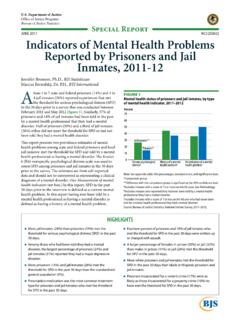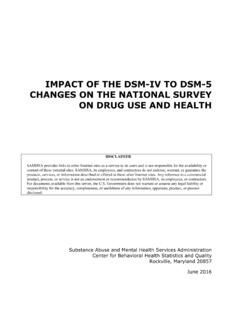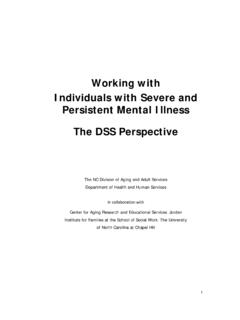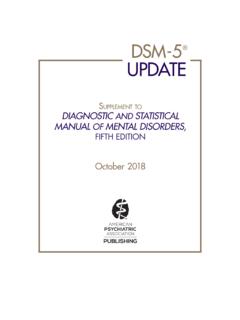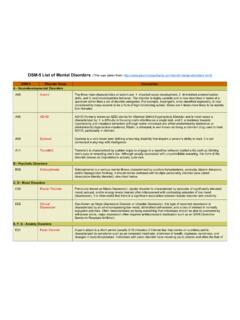Transcription of ental Health and Chronic DiseasesM - Centers for Disease …
1 Mental Health and Chronic Diseases National center for Chronic Disease Prevention and Health Promotion Division of Population Health Issue Brief No. 2 October 2012 Background Chronic diseases are non-communicable illnesses that are prolonged in duration, do not resolve spontaneously, and are rarely cured completely. They are the leading cause of death and disability in the United States. They cause 7 o ut of 10 deaths each year and are among the most preventable and treatable of all Health problems (see figure below). Chronic diseases include illness such as heart Disease , diabetes, cancer, and Mental Health disorders are medical conditions that disrupt a person's thinking, feeling, mood, ability to relate to others and daily functioning. They are medical conditions that often result in a reduced ability to cope with the routine daily activities such as going to work or raising a family.
2 Just like Chronic diseases, mental Health disorders are treatable. Most people diagnosed with a serious mental Health disorder can receive relief from their symptoms by following a treatment plan specifically designed for them by a trained psychologist or psychiatrist. Mental Health disorders are not exclusive to those who exhibit a lack of personal strength, personality traits like being shy, or have a certain socioeconomic status. Mental Health disorders include illnesses such as major depression, bipolar disorder, obsessive compulsive disorder, and post-traumatic stress disorder. One common finding is that people who suffer from a Chronic Disease are more likely to also suffer from Scientists have yet to determine if having a Chronic Disease increases the prevalence of depression or depression increases the risk of obtaining a Chronic Disease . Regardless of the cause, Chronic diseases and mental Health disorders are treatable and employers can use multiple strategies to make their work environments more supportive of overall physical and mental Health and general well-being.
3 What causes mental Health disorders and Chronic diseases? While cause(s) for mental Health disorders are unknown, there are certain factors that can increase an individual s risk of developing a mental Health disorder. The risks and causes of Chronic diseases are much more well-established. Below is a list of the common risk factors for mental Health and Chronic diseases. Mental Health Chronic Disease Risk Factors3 Modifiable Risk Factors1,4 Non Modifiable Risk Factors4 Family history Stressful life conditions Having a Chronic Disease Traumatic experience Use of illegal drugs Childhood abuse or neglect Lack of social support Poor Eating Habits Lack of Physical Activity Tobacco Use Excessive Alcohol Use Environmental Factors Socioeconomic Status Age Family History Relationship between mental Health , Chronic Disease , and injury Both mental Health disorders and Chronic diseases are common and disabling.
4 These conditions can affect anyone, regardless of age, culture, race/ethnicity, gender, or income. In 2009, 145 million people almost half of all Americans were living with a Chronic Approximately 26% of American adults aged 18 years and older suffer from a diagnosable mental disorder in a given Arthritis, as a Chronic condition, and depression, as a mental Health illness, are both leading causes of disability worldwide. Many other associations exist between mental illness and cardiovascular Disease , diabetes, obesity, asthma, and arthritis to name a ,8 For example, the chart to the right shows the prevalence of major depressive disorder and other common Chronic diseases. Depression is found to co-occur in 17% of cardiovascular cases, 23% of cerebrovascular cases, and with 27% of diabetes patients and more than 40% of individuals with ,10 The relationship between mental Health , Chronic Disease and injury is significant.
5 Many examples exist of individuals with a Chronic condition or risk factor and an increased risk for mental illness such as the risk for tobacco use is about twice as high for those with mental illness compared to the general Injuries, both intentional such as homicide and suicide and unintentional such as motor vehicle accidents, are 2 6 times higher for persons with a history of mental illness than those without a ,12 Issue How does mental Health and Chronic Disease affect employees and the workplace? The cost to treat those with Chronic diseases is approximately 75% of the total national Health Expenses related to cardiovascular Disease alone were estimated to be $503 billion in Direct and indirect costs associated with mental Health are also costly. The Agency for Healthcare Research and Quality found that in 2006, $ billion was spent on mental Health care in the Unites It is estimated that about one-third of those with mental illnesses are One study estimates nearly a quarter of the workforce (28 million workers aged 18 54 years) experience a mental or substance abuse The most common mental illnesses in the workplace are alcohol abuse or dependence (9% of workers); major depression (8%); and social anxiety disorder (7%).
6 Most importantly for employees and employers is that 71% of workers with mental illnesses have never sought help from a medical or mental Health specialist for their symptoms. For depression in particular, approximately 80% of persons with depression report some level of functional impairment because of their depression, and 27% reported serious difficulties in work and home The condition can also have a large effect on productivity. In a 3 month period, patients with depression miss an average of workdays and suffer days of reduced Depression alone is estimated to cause 200 million lost workdays each year at a cost to employers of $17 to $44 ,20 Employers and employees have, in turn, had to bear the burden of rising Health care costs. There has been a 97% increase in premiums for employer-sponsored Health coverage since Most of the financial burden of mental Health disorders is not from the cost to treat the illness.
7 It is because of income loss from unemployment, expenses for social supports, and indirect costs such as workers compensation, short-and long-term disability, presenteeism (the measurable extent to which Health symptoms, conditions, and diseases adversely affect the work productivity of individuals who choose to remain at work) and ,22 Complications because of untreated Chronic diseases and mental Health disorders are the primary cause of missed work and increased presenteeism. Even though there have been increased attention on mental Health in recent years, social stigma and discrimination associated with mental illnesses remains a significant barrier to an individual s Health and employment. These issues often affect whether or not an individual will apply for a job or promotion when qualified. Stigma and discrimination may also prevent an employee from seeking help contributing to presenteeism and absenteeism and if treatment is sought out it may complicate the transition back to work.
8 Both managers and coworkers alike are often unaware or uncertain how to interact with someone recovering from a mental Health disorder. 2. Many employees will not voluntarily disclose that they suffer from a Chronic Disease or mental Health disorder for fear of being stigmatized. This burden leads to added stress that can exacerbate their condition. In addition, not divulging this information prevents the employer from understanding to what extent some of these Health issues are problems and subsequently taking action, such as changing the work environment through a workplace Health program. For example, some instances of this include how organizing and structuring work can contribute to job related stress that can put the individual at an increased risk for Chronic Disease such as cardiovascular Disease (see figure to the left).
9 These organizational stressors include psychosocial stressors such as high job demands, low job control for the worker, or social isolation; scheduling issues including shiftwork or long hours;, the physical demands of work whether the position is mostly sedentary or involves heavy physical exertion; exposure to hazardous chemicals such as tobacco smoke or lead; and the broader work environmental conditions ( , noise, heat, cold, little access to healthy food). Through a workplace Health program, employers can identify and take steps to improve the work environment to minimize the effect these organizational factors have on employee physical and mental Health . Opportunity Although both Chronic Disease and mental Health disorders are common, strategies exist that can prevent or effectively treat the conditions. Modifiable risk behaviors ( , tobacco use, physical inactivity, and poor nutrition) that contribute to a number of Chronic diseases and mental Health disorders can be targeted and a point of emphasis of a workplace Health program.
10 It is never too late to address both modifiable individual risk factors and environmental risk factors like job stressors. For those that need treatment for more serious Disease , the benefits component of a comprehensive workplace Health program can provide access to professional therapy, medications, self-help, and community support programs. What are the best practices for maintaining employees mental Health and Chronic Disease status? The Substance Abuse and Mental Health Services Administration has developed a tool kit to help workplaces become more mental Health -friendly. It describes program and practice strategies that address overall well-being by placing emphasis on both physical and mental Health . The main elements of a Mental Health -Friendly Workplace include 23 A workforce where diversity is valued. Health care that treats mental illnesses with the same urgency as physical illnesses.










